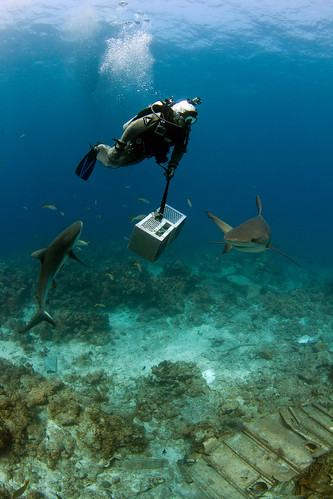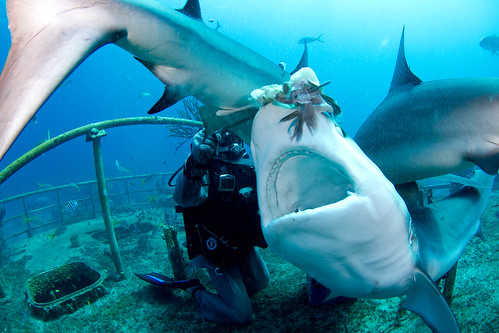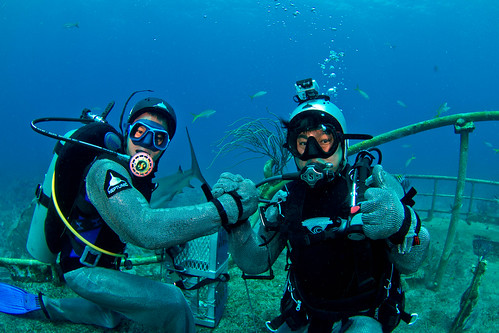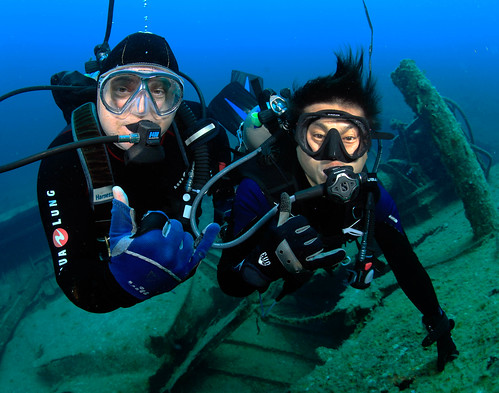Joi's diving blog
My name is Joi Ito and I'm a PADI IDC Staff Instructor, EFR Instructor and DAN Instructor Trainer. This is my diving blog. My main blog is Joi Ito's Web which has an English section and a Japanese section. My other main deposit of stuff is my Flickr stream.
Search
Additional pages
- Instructor Ratings
- Certifications
- Open Water Scuba Dive Log
- Favorite Dive Shops and Charters
- Diving Buddies
- Marine life photography - Wikimedia
Site authors
Find me on...
Diving in the Bahamas - Finished my IDC and learned how to feed sharks
Sharks following me down to the feeding area - Photo by Sebastien Filion / Stuart Cove’s
Feeling a bit guilty as Japan still struggles with the aftermath of the earthquake, I decided to spend a few days in the Bahamas finishing up my PADI Instructor Development Course (IDC) with Grant before what appears to be a wave of work approaching me hit.
We spent the first few days in the classroom at Stuart Cove’s doing the classroom stuff and later did the teaching skills demonstrations in the pool and off to the boat. I completed all of the requirements, so pending paperwork, I am now PADI Assistant Instructor. (I liked “Divemaster” better, but in PADIland, an AI is one step up from Divemaster.) If I pass my Instructor Exam at the end of this month, I will be an Open Water Scuba Instructor. (Knock on wood…)
After we finished the IDC, we had a bit of time left so I took the shark feeder and shark aware class at Stuart Cove’s with Chang.
Shark feeding is a somewhat controversial subject. The argument against shark feeding is that they are wild animals, that it might condition them to associate human beings with food and that it could make sharks dependent on human beings and feeding for food. Feeding wild animals is generally forbidden and shark feeding is banned in many places including Florida.
People who argue for shark feeding will explain that while sharks near feeding areas will become somewhat accustomed to feeding. However, tagging and tracking has shown that a shark’s range and feeding behavior when the feeders are not around does not appear to be affected. Sharks from the Bahamas feeding areas have shown up as far away as South Africa.
The amount of food that is being given to the sharks is quite small and not nearly enough for them to become dependent or able to sustain themselves.
Me feeding Carribean reef sharks on a wreck - Photo by Sebastien Filion / Stuart Cove’s
I am generally against feeding wild animals and domestic animals that are not yours, but after looking at the facts around sharks, my personal opinion is that the conditioning and negative impact is minimal and the positive impact on dispelling fears and allowing us to capture images of and learn more about sharks has tremendous value.
Shark are opportunistic predators feeding on injured or weak fish and in the case of some species, turtles or seals. Some sharks like the great whites attack these animals on the surface and unfortunately, swimmers and surfers can look and sound a lot like seals or turtles.
Having said that, shark attacks are very rare. I’ve read that the number of crocodile victims in one year exceeds all recorded shark attacks. I’ve also read that more people are killed by wild pigs each year than by sharks.
Having gone diving with sharks and experienced exactly how picky they are and focused they are on eating only food that they can easily eat (high return / energy expended), I’m sure that a shark would never eat a human being or a human limb on purpose.
The only way to predictably see sharks up close is to draw them in with shark food, which feeders call “chum". The sharks really aren’t interested in human beings who aren’t feeding them.
There are many different styles of shark feeding, but most of them involve gathering local fish or leftovers of processed local fish to feed to the sharks. If you’re trying to attract sharks in open water or a location that doesn’t have many sharks, you may need to “chum for awhile allowing the smell to draw the sharks in. Most sharks have a very good sense of smell and can follow the scent from far away. As the sharks approach, most sharks switch to visual, vibration and sound queues to locate their food.
Unfortunately bare feet kicking underwater or on the surface sounds like injured fish and is one cause of shark attacks - sharks mistaking bare feet for hurt and struggling fish. Luckily for divers, divers don’t look like or sound like food.
After the sharks get close to the feeder, they begin to circle the diver/feeder. The key to feeding sharks safely is to feed the in a controlled way. There are roughly three “modes” of shark feeding - controlled, fast and frenzy.
Controlling the box while sharks circle - Photo by Sebastien Filion / Stuart Cove’s
If you dump a huge amount of food in the water at once, the sharks will go into a frenzy biting at everything, trying to get as much food as possible before it disappears. This is a dangerous situation where it’s possible to get bitten by mistake. You don’t ever want to be in a shark feeding frenzy.
If you feed the sharks too fast, they begin to get aggressive or “fast”, snapping and being fairly unpredictable. This is also risky.
A good feeder feeds one shark at a time every minute or two, waiting for the sharks to calm down between feeds. The feeder doesn’t control the sharks, but can exercise a great deal of influence on their mood and behavior.
My shark instructor Chang and me after our shark feed - Photo by Sebastien Filion / Stuart Cove’s
The method that I learned from my feeder instructor, Chang, was to use a spike to skewer a fish and hold it down until I could identify an appropriate shark to feed. The key was to identify a shark coming from the left side, put the fish in front of the shark so that the shark could smell it, and then pull the fish up and to the right to allow the shark to sense the motion and grab the fish. It was important to make sure the area was clear of other sharks that might try to grab the fish too or mistake my hand for the fish and bite that instead.
As the shark approaches its prey, it opens its mouth, covers its eyes with the nictitating membrane to protect them from chomp debris and uses ampulla of Lorenzini (sensors that detect electricity) to home in on the prey. Many sharks have poor eyesight and the motion is a very important way for sharks to detect prey.
A few times, sharks mistook my hand for the fish and one time I got a pretty good bite. However, the shark quickly figured out that it wasn’t food and let go. One shark got her teeth stuck in my chainmail and it was a bit awkward for both of us for a moment. Sharks, like dogs and babies, will bite things to try to figure out what they are. The bite on my hand and some of the nibbles on my leg reminded me a lot of puppies biting toys and hands.
Luckily I had a Neptunic chainmail shark suit on or the bite may have broken the skin, but with the chainmail, the bite didn’t hurt at all and I was able to be surprisingly calm. Chang had taught me a few “moves" to deal with these situations as well.
After each feeding, the sharks that didn’t get any food tended to bump into me or come looking for the food and become slightly aggressive, but even though some of them were 7 feet long and probably over 400 pounds, I was able to push them away or rub their notes and guide them away from my legs or the box of food.
Rubbing the nose of a shark puts them in a catatonic state that looks like a form of paralysis. They don’t know exactly what causes this, but some say it’s a sensory overload on the huge number of electrical sensors they have on their nose. In any case, it was relatively easy to handle the eight or so sharks that were circling me and feed them in a controlled way.
Experienced shark feeders will hold a shark still in a catatonic state to remove hooks in sharks fins and mouths. Someday, I hope I’ll be able to do this. A surprising number of sharks had hooks and I felt like spending all day removing them.
Overall, shark feeding was one of the most interesting and rewarding experiences I’ve ever had and I highly recommend it. Even though I was quite sympathetic to sharks after all of the movies and books about them, diving with and playing with sharks substantially increase my compassion and connections to sharks.
Grant and Joi - photo by Cathy Ridsdale / Stuart’s Cove
Thanks Grant, Chang and everyone at Stuart Cove’s for the great experience.
Also, thanks Grant and yay me on the IDC.




